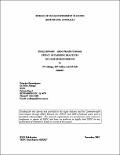| Abstract | The impact of farming practices on numbers of Childers canegrubs was determined in southern Queensland by a survey of 441 field-year combinations that related practices to the numbers of second- and third-instar larvae in those fields, and by a field experiment that tested combinations of insecticide application, cultivation practices and crop-residue retention on numbers of larvae and associated entomopathogens. There were significant differences in levels of infestation among years, soil types, crop ages, cultivars grown, insecticide-use strategies, crop-replacement strategies, intensity and frequency of tillage during crop replacement, and irrigation strategies. In the field trial, numbers of third-instar larvae declined as the larvae aged, probably through infection by the fungus Metarhizium anisopliae and the protozoan Adelina sp. Application at planting of the controlled-release insecticide suSCon? Blue had an immediate effect on the number of larvae carried over from the previous crop cycle and this effect continued into the second-ratoon crop. The insecticide application increased cane and sugar yields, particularly in the first-ratoon crop. More intensive preplanting tillage initially reduced numbers of larvae, but the effect did not continue into the ratoon crops. Management of crop residues had no consistent impact on numbers of larvae, but cane yields were higher and sugar content lower in the second-ratoon crop when residues were retained, and led to higher sugar yields where suSCon? Blue had been applied. In general, long breaks between successive sugarcane crops, coupled with intensive tillage in that break and application of controlled-release insecticide, will reduce subsequent populations of larvae. The alternative strategy of herbicide destruction of the previous crop, long fallow with minimum tillage, replanting without controlled-release insecticide and prudent use of transient insecticides in heavily infested ratoon crops will also minimise numbers and may allow better survival of entomopathogens. These strategies are integrated into management practices attractive to growers and have been extended within the Southern GrubPlan format. |

